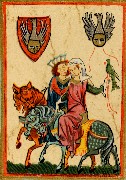 |
In
14th C. France, the Miracles de Notre Dame par personages
were performed annually by the Paris goldsmith guild, including a saint's
play about Saint Valentin.2
There
is no clear connection with lovers or birds until Otto
de Granson & Geoffrey Chaucer wrote Valentine
poetry. Granson (1346-1397) was a landed knight and amateur
poet in the service of John of Gaunt after 1374; his extant
works include seven Valentine poems. Chaucer also features
Valentine's Day in several of his poems, most notably, his Parliament of Fowls
(ca. 1380) is "the book of Seint Valentynes Day."3
|
|
According to
studies by Henry
Kelly and Jack Oruch, the connection of Valentine's Day with the
pairing of lovers was unknown before Granson and Chaucer who virtually originated the occasion as we know it.
Granson seems
to be the first to write love poems for Valentine's Day, before
1374, while Chaucer pioneered the crucial involvement of birds.3
|
 |
|
Saint
Valentine
of Terni. A bishop of Terni, suffered martyrdom (beheaded) on this
day, about 270 A.D. His body was buried on the via Flaminia where, in
the 4th century, were graves of two martyrs. Although
the Roman Martyrologium assumes that there were two
martyrs, there may have been only one person.1
The
association of fertility and spring renewal with this season harkens back
to the 3rd century B.C. with the Roman celebration of Lupercalia, a
festival celebrating the deity Lupercus, identified with Pan, the Greek
god. In Christ's time, the Luperci priests still danced in the
streets on their festival day, February 15th. |
 |
Extensive
scholarly research has found comparatively little in the legend of the
saint to connect him with lovers. Yet it may be significant that
Granson's Balade de Saint Valentin double, which could be the
earliest of these poems, makes the most extensive reference in them
to the saint and his feast. The speaker begins by noting that he
chose his lady seven and a half years ago, and declares that on this day
he once again chooses her; he invokes the day and the saint in the
fourth stanza, which he addresses to Valentine. Throughout the poem there is no mention of mating birds.3 |
|
Chaucer
states, in Parliament of Fowls, that his assembly of birds occurred:
"on seynt Volantynys day When euery byrd comyth there to chese
his make" and he makes clear that Nature summons them each year on
that day for that purpose. At the conclusion his birds also address
the saint in heaven, "Saynt Valentyn, that art ful hy on-lofte,"
professing to sing for his sake. |
 |
|
|
|
|
|
|
Granson's
last poem Songe Saint
Valentin, probably after Chaucer, mentions birds. The next
English poems by John Gower (1325-1408) and Sir
Thomas Clanvowe speak of the day when birds choose their mates;
however, birds do not figure in the next French Valentinian verse,
by Christine
de Pisan (1364-1430) and Jean de Garenci�res.3
Valentine's
Day 15th to 19th century
1Clemens Jockle,
Encyclopedia of Saints, Alpine Fine Arts Collection, Ltd.,
London, 1995
2William Kibler & Grover Zinn, eds., Medieval France, an
Encyclopedia, Garland Publishing, NY & London, 1995
3James Wimsatt,
Chaucer
and His French Contemporaries, University of Toronto Press, 1991
|
|
|